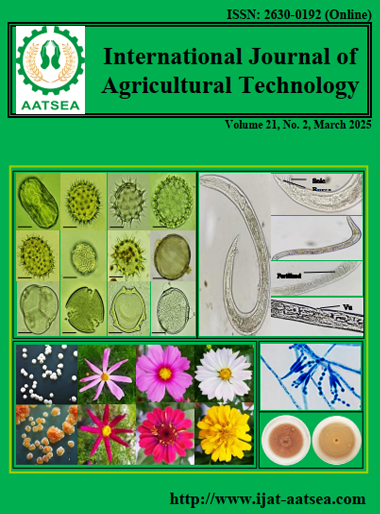Effect of seed soaking with nitrophenolate–based biostimulant on germination and growth of chilli var. Kanchanaburi 1
Main Article Content
Abstract
The results showed that there was significant difference in germination rate. Three ppm of nitrophenolate–based biostimulant increased the germination rate more than the other treatments. However, there was no significant difference among treatments in the leaf number at 14 and 21 days after planting and also the plant height at 14 days after planting. The seeds which were soaked in 7 ppm of nitrophenolate–based biostimulant for 5 hours, resulted in the tallest plant height at 21 days after planting.
Article Details

This work is licensed under a Creative Commons Attribution-NonCommercial-NoDerivatives 4.0 International License.
References
Alcalá-Rico, J. S. G. J., López-Benítez, A., Vázquez-Badillo, M. E., Sánchez-Aspeytia, D., Rodríguez-Herrera, S. A., Pérez-Rodríguez, M. A. and Ramírez-Godina, F. (2019). Seed Physiological Potential of Capsicum annuum var. glabriusculum Genotypes and Their Answers to Pre-Germination Treatments. Agronomy, 9:1-12.
Al-Musawi, M. H. K. (2023). Effect of growth regulator (atonik) and zn-nano-fertilizer on sweet pepper (Capsicum Annuum L.). IOP Conference Series: Earth and Environmental Science. Retrieved from https://doi.org/10.1088/1755-1315/1259/1/012059
Barchenger, D. W. and Bosland, P. W. (2016). Exogenous applications of capsaicin inhibits seed germination of Capsicum annuum. Scientia Horticulturae, 203:29-31.
Diel, M. I., Valera, O. V. S., Pinheiro, M. V. M., Thiesen, L. A., Meira, D., Jesus de Melo, P., Junges, D. L., Caron, B. O. and Schmidt, D. (2019). Temperature and light quality influence seed germination of two biquinho pepper cultivars. Bulgarian Journal of Agricultural Science, 25:1007-1014.
Djanaguiraman, M., Sheeba, J. A., Devi, D. D. and Bangarusamy, U. (2005). Effect of atonik seed treatment on seedling physiology of cotton and tomato. Journal of Biological Sciences, 5:163-169.
DOAE (Department of Agricultural Extension). (2016). Announcement of guaranteed plants. Retrieved from https://www.doa.go.th/pvp/wp-content/uploads/2019/11/ AnnoDOA_Public112.pdf
Finch-Savage, W. E. and Leubner-Metzger, G. (2006). Seed dormancy and the control of germination. New Phytologist, 171:501-523.
ITCC DOAE (Information Technology and Communication Center, Department of Agricultural Extension). (2022). Pepper. Retrieved from http://www.agriman.doae.go.th/home/news/2565/22chili.pdf (in Thai)
Kaewsorn, P., Chotanakoon, K., Chulaka, P. and Chanprasert, W. (2017). Effect of Seed Priming on Germination and Seedling Growth of Pepper. Agricultural Science Journal, 48:70-79.
Khaba, C. I., Luikham, S., Devi, C. P., Singh, N. A., Chandam, M., Kumar, K. S. D. S. P. and Nath, P. D. (2020). Enhancing seed germination of king chilli (Capsicum chinense Jacq.) using pre-treatment solutions. Retrieved from https://doi.org/10.22271/phyto.2020.v9.i2f.10879
Materska, M. and Perucka, I. (2005). Antioxidant activity of the main phenolic compounds isolated from hot pepper fruit (Capsicum annuum L.). Journal of Agricultural and Food Chemistry, 53:1750-1756.
Przybysz, A., Gawronska, H. and Gajc-Wolska, J. (2014). Biological mode of action of a nitrophenolates-based biostimulant: case study. Frontiers in Plant Science, 5:1-15.
Stutte, C. A. and Clark, T. H. (1990). Radiolabeled studies of atonik in cotton using HPLC. Arysta Life Science Report. Fayetteville, AR: Altheimer Laboratory, University of Arkansas.
Sun, T., Xu, Z., Wu, C.T., Janes, M., Prinyawiwatkul, W. and No, H. K. (2007). Antioxidant activities of different colored sweet bell peppers (Capsicum annum L.). Journal of Food Science, 72:98-102.
Surendar, P., Sekar, K., Sha, K. and Kannan, R. (2020). Effect of plant growth regulators on growth of chilli (Capsicum annuum L.). Plant Archives, 20:1544-1546.
Wilson, G. F. and Kaczmarek, L. K. (1993). Mode-switching of voltage-gated cation channel is mediated by a protein kinase A-regulated tyrosine phosphatase. Nature, 366:433-438.
Yadav, P. V., Kumari, M. and Ahmed, Z. (2011). Chemical seed priming as a simple technique to impart cold and salt stress tolerance in Capsicum. Journal of Crop Improvement, 25:497-503.
Yamaki, T., Nakasawa, K., Nakamura, K., Terakawa, H. and Hayashi, T. (1953). A plant physiological study of Atonik (Advance Report). Agriculture and Horticuture, 28:1-3.
Yuniati, N., Kusumiyati, Mubarok, S. and Nurhadi, B. (2019). Germination performance and seedling characteristics of chili pepper after seed priming with leaf extract of Moringa oleifera. Agronomy Research, 21:410-422.


